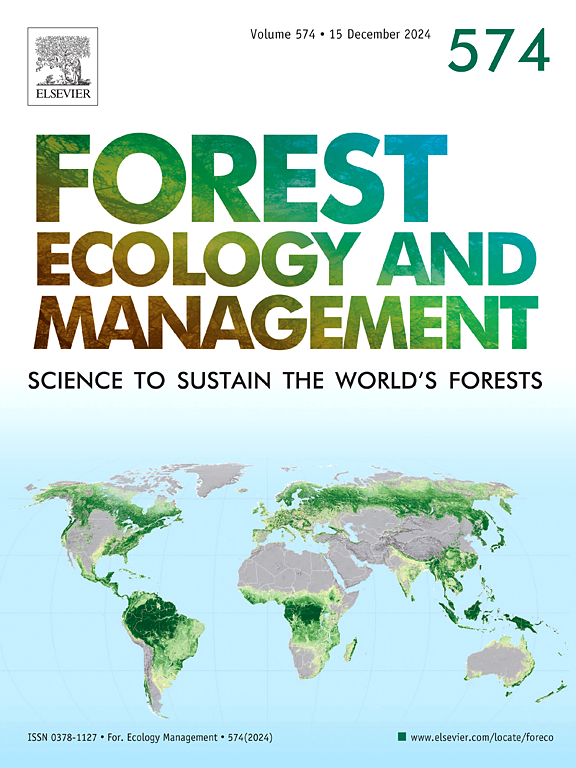利用PlanetScope高分辨率卫星图像和时间序列机器学习模型识别西班牙保护区金合欢入侵物种:森林保护管理的重要行动
IF 3.7
2区 农林科学
Q1 FORESTRY
引用次数: 0
摘要
自然保护区是世界上重要的生态系统,为许多独特的动植物提供了宝贵的栖息地。然而,近年来,它们受到许多自然和人为因素的破坏。这些生态系统中森林的主要破坏因素之一是入侵植物物种的建立。本研究旨在利用高分辨率卫星图像和机器学习方法在时间序列中绘制西班牙西北部Cíes岛屿的森林面积和金合欢sp.分布(作为主要IPS)。为此,获得了2016年6月、2020年6月和2024年6月研究区域的PlanetScope卫星图像。此外,在野外调查中还收集了金合欢树种在森林覆盖中的位置和分布等数据,作为实地资料。采用四种机器学习算法(RF、SVM、DT和ANN)对森林覆盖进行时间序列分离。结果表明,随机森林(Random Forest, RF)算法是研究区森林覆盖分类最准确的方法(2016年,OA: 89.16 %,k: 0.86;2020年,OA: 93.33%, k系数:0.91;2024年,OA: 95.83%, k值:0.93)。此外,基于RF算法的结果表明,Cíes岛屿的森林面积在8年内有所增加(2016年:129.99 ha, 2020年:134.05 ha, 2024年:135.45 ha)。结果表明:4年间(2016-2020年)金合欢属植物面积增加28.01%,4年后(2020-2024年)面积减少21.31%;对金合欢属植物分布图的验证表明,RF对Cíes岛屿不同年份的金合欢属进行了有效的分类(2016年,OA: 86.66%, k: 0.82;2020年,OA: 90, k系数:0.87;2024年,OA: 95%, k≤0.91)。本研究提出了一种创新的方法,将卫星图像和机器学习模型相结合,为森林管理者抵御入侵植物物种提供实用工具。本研究绘制的地图有助于在气候变化挑战的背景下保护保护区内的生物多样性。本文章由计算机程序翻译,如有差异,请以英文原文为准。
Identification of Acacia invasive species in protected areas of Spain using PlanetScope high-resolution satellite images and machine learning models in time series: an important action for protective management of forests
Natural protected areas are important ecosystems in the world which provide valuable habitats for many unique fauna and flora. However, they have been destroyed by many natural and anthropogenic factors in recent years. One of the main destructive factors of forests in these ecosystems is the establishment of Invasive Plant Species (IPS). This study aims to map the forest area and Acacia sp. distribution (as the main IPS) in Cíes Islands in northwestern Spain using high resolution satellite images, and machine learning methods in time series. For this purpose, PlanetScope satellite images of the study area were obtained for June of 2016, 2020, and 2024. In addition, some data of location of tree species in forest cover and distribution of Acacia sp. were collected during fieldworks to use them as ground truth data. Four machine learning algorithms (RF, SVM, DT, and ANN) were used to separate the forest cover in time series. Results showed that Random Forest (RF) algorithm was the most accurate method to classify forest cover in the study area (for 2016, OA: 89.16 %, : 0.86; for 2020, OA: 93.33 %, : 0.91; for 2024, OA: 95.83 %, : 0.93). In addition, results demonstrated that the forest area increased in Cíes Islands during 8 years based on RF algorithm (2016: 129.99 ha, 2020: 134.05 ha, 2024: 135.45 ha). Results showed that the area of Acacia sp. increased about 28.01 % in these islands over 4 years (2016–2020) and then decreased about 21.31 % in following 4 years (2020–2024). Validation of Acacia sp. distribution maps showed that RF has effectively classified Acacia sp. in Cíes Islands in different years (for 2016, OA: 86.66 %, : 0.82; for 2020, OA: 90, : 0.87; for 2024, OA: 95 %, : 0.91). This study presented an innovative methodology that combined satellite imagery and machine learning models to provide the practical tools for forest managers against invasive plant species. The maps produced in this study facilitate the conservation of biodiversity inside protected areas in context of challenges of climate change.
求助全文
通过发布文献求助,成功后即可免费获取论文全文。
去求助
来源期刊

Forest Ecology and Management
农林科学-林学
CiteScore
7.50
自引率
10.80%
发文量
665
审稿时长
39 days
期刊介绍:
Forest Ecology and Management publishes scientific articles linking forest ecology with forest management, focusing on the application of biological, ecological and social knowledge to the management and conservation of plantations and natural forests. The scope of the journal includes all forest ecosystems of the world.
A peer-review process ensures the quality and international interest of the manuscripts accepted for publication. The journal encourages communication between scientists in disparate fields who share a common interest in ecology and forest management, bridging the gap between research workers and forest managers.
We encourage submission of papers that will have the strongest interest and value to the Journal''s international readership. Some key features of papers with strong interest include:
1. Clear connections between the ecology and management of forests;
2. Novel ideas or approaches to important challenges in forest ecology and management;
3. Studies that address a population of interest beyond the scale of single research sites, Three key points in the design of forest experiments, Forest Ecology and Management 255 (2008) 2022-2023);
4. Review Articles on timely, important topics. Authors are welcome to contact one of the editors to discuss the suitability of a potential review manuscript.
The Journal encourages proposals for special issues examining important areas of forest ecology and management. Potential guest editors should contact any of the Editors to begin discussions about topics, potential papers, and other details.
 求助内容:
求助内容: 应助结果提醒方式:
应助结果提醒方式:


